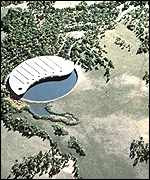 Scientists at Indian Institute of Science are claiming to have made advancements towards discovering a Holy Grail of the illumination industry — a white LED, a light-emitting diode that produces pure white light suitable for interior lighting of homes, offices and other buildings.
Scientists at Indian Institute of Science are claiming to have made advancements towards discovering a Holy Grail of the illumination industry — a white LED, a light-emitting diode that produces pure white light suitable for interior lighting of homes, offices and other buildings.In a report presented, D. D. Sarma and Angshuman Nag point out that practical versions of these so-called white LEDs would be brighter, longer-lasting and more energy efficient than conventional light sources such as incandescent and fluorescent lamps and could replace them in the future. The existing versions produce tinted, unstable shades of white light that mar their performance.
The researchers report the first success in developing a new LED based on a new phosphor from semiconductor nanocrystals of cadmium sulfide mixed with manganese. It produces a stable shade of white light that remains constant over time and appears superior in overall performance in comparison to previous generations of white LEDs. The scientists now are working to boost its efficiency so that the white LED can be used in everyday applications.















